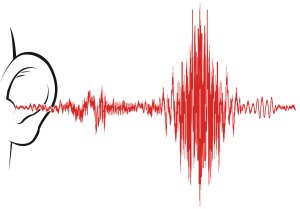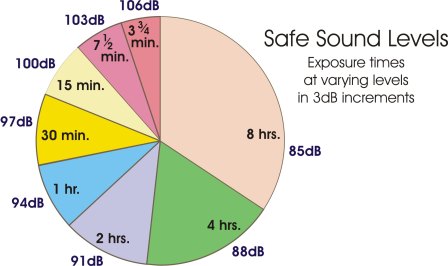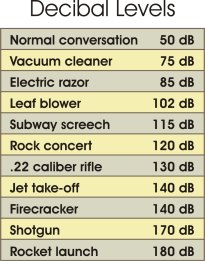Hearing Safety
by Laurence B. Abrams
“That Sound Mixer can hear grass grow!”

It’s an expression we’ve heard often, suggesting that the Production Sound Mixer is capable of listening so intently as to be aware of even the slightest and most subtle of sounds. Quite true. Even as developments in digital audio processing provide more tools and methods for suppressing extraneous and unwanted sounds, there is still no substitute for clean tracks … and when they get them, Sound Editors and Producers are thankful for the time and money saved when minimal repair is required.
This type of critical listening relies not just on training and knowing what to listen for but also on healthy ears capable of differentiating a wide range of the audio spectrum. That is why it’s so important to have an informed understanding of how to protect your ears from situations that can cause irreversible and, perhaps, even career-ending hearing damage.
The auditory system is an extraordinarily intricate and fragile mechanism built for the singular purpose of converting acoustic energy into electrical energy. Once transmitted to the brain, this complex surge of electrical pulses is processed and interpreted into the lush tapestry of voices, music and sounds that fill our world.
But this remarkably evolved sensory structure does not always perform fully up to spec. To a hearing specialist, a failure of the auditory system is described as either Conductive Hearing Loss or Sensorineural Hearing Loss. Conductive Hearing Loss can result from the buildup of earwax or from certain diseases and disorders. In such cases, a visit to an Ear, Nose and Throat (ENT) physician can often provide treatment that will improve hearing.
The prognosis for Sensorineural Hearing Loss, however, is less encouraging. This type of hearing loss is associated with a variety of nerve-based disorders and occurs when one of the two critical components of the auditory system are damaged or compromised. These two mechanisms are the microscopic hair cells of the cochlea, which vibrate in response to the sound waves they are exposed to, and the nerve fibers, which transmit electrical signals to the brain. This type of hearing loss usually turns out to be irreversible.
Sensorineural Hearing Loss can be genetic, age-related, triggered by disease and high fever … and it can be caused by excessive and cumulative exposure to very loud noises.
Repeated exposure to loud sound levels permanently damages the microscopic hairs of the cochlea, causing the gradual loss of hearing. This Noise-Induced Hearing Loss (NIHL) accounts for more than 30% of all cases of permanent hearing loss in the United States. The main factors that impact Noise-Induced Hearing Loss are:
• Loudness
• Duration
• Frequency
Loudness, of course, is measured in decibels (dB). The decibel is a logarithmic unit of measurement, which is to say that an increase of 10dB indicates that the sound levels and the air pressures have become 10 times more intense. In a qualitative sense, however, that same tenfold increase in sound pressure tends to be perceived as though it were only about twice the loudness. This deceiving difference between actual change in loudness and perceived change in loudness makes it all too easy to be unaware of potentially harmful sound levels. Furthermore, recent studies have shown that one’s perception of loudness diminishes significantly after prolonged exposure. The longer damaging noise levels are present, the greater the risk … and yet the less likely you are to notice that the levels are so high as to endanger your hearing.
Damage to the ear can be caused either by very loud sounds in short duration (such as gunshots) or by moderately high-volume sounds that are longer in duration. At first glance, that message is fairly intuitive … the louder the noise, the less time your ears can tolerate exposure to it before some degree of damage occurs. But the chart below reveals the reality about the nonlinear relationship between levels and exposure.

With just a 3dB increase in sound levels, the safe exposure time is cut in half … and each subsequent increase of 3dB cuts the safe time by yet another half. To put this into real-world perspective:
• With an average output of about 80dB, you can let the alarm clock ring all day long.
• A lawn mower putting out about 90dB can begin to cause hearing loss in a little more than two hours.
• Turn on the leaf blower at 102dB and you’re beginning to damage your unprotected ears after only about seven minutes.
• Some rock concerts are as loud as 120dB but even a more tame concert at 110dB starts to induce hearing damage in LESS THAN TWO MINUTES.
• A jet takeoff at 140dB? Do the math.

Noise-Induced Hearing Loss is cumulative and the higher frequencies are usually the first to go. You might not notice it after a single occurrence, but the effect is additive over time. Tinnitus (ringing in the ears) is another consequence of this type of hearing damage. While some of these symptoms are temporary, with a limited degree of recovery within 24 to 48 hours, the unfortunate truth is that all those rock concerts you attended in your carefree youth probably did chip away at your hearing. The only thing you can do about it now is to take measures to prevent it from getting worse.
Here are some things that you can do to reduce further hearing damage:
• Be aware that noises above 85dB can begin to cause hearing damage after prolonged or repeated exposure.
• Sounds very much louder than 85dB should be avoided whenever you can.
• Don’t run the gain on your headphones any louder than you absolutely need to and perhaps reduce the headphone level a little bit when the camera’s not rolling.
• When there is something loud happening on set, like Ritter fans or gunshots or trains or loud machinery, let your closed-ear headphones provide you with some protection by muffling the sound a little bit and consider using foam earplugs when practical.
• After periods of exposure to loud sounds, give your ears a chance to rest and recover with a 15-minute break far from the noise source.
• It may be too late for you to undo the past damage but make sure to tell your kids that with ear buds plugged tightly into the auditory canal, their mobile phones and MP3 players need to be operated at safe levels at all times. And remind them that foam earplugs are cheap and easy to bring to music concerts and that there’s nothing at all “uncool” about wearing them … in fact, if you look closely, you’ll see that almost every rock musician performing on the stage today wears a custom set of noise-suppressing earplugs at every performance.
Good hearing is essential for the work we do. Take measures to protect your ears from prolonged exposure to sound levels above 85dB. If you suspect that your hearing has diminished, see a physician who specializes in hearing disorders. Further information and advice about maintaining good hearing health and safety can be found on the website of the House Ear Institute at http://www.hei.org. Most importantly, be smart and protect your ears whenever you can.